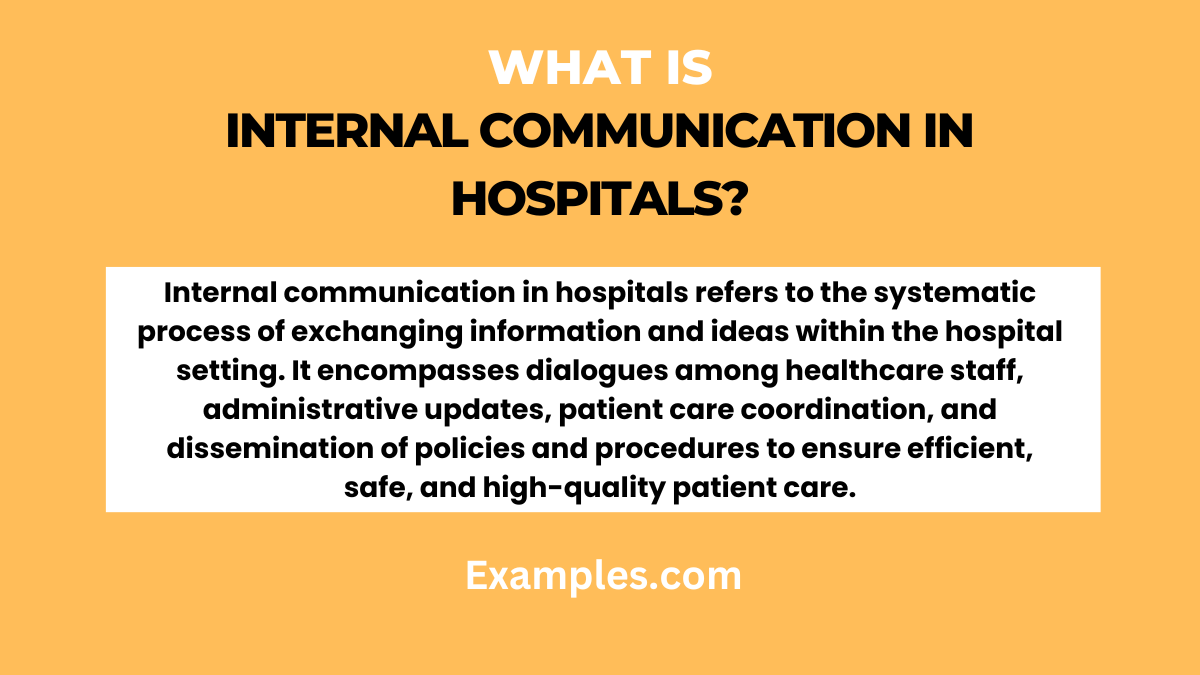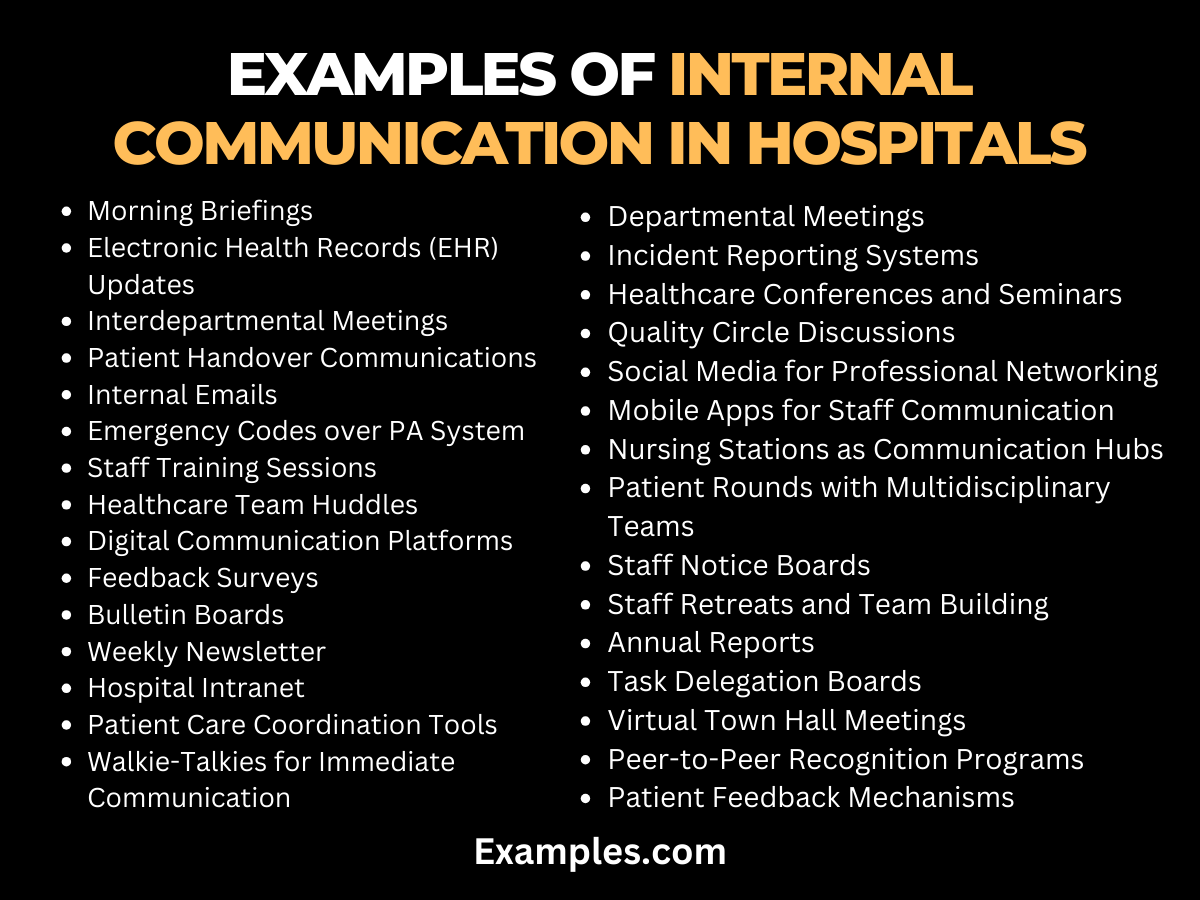29+ Internal Communication in Hospitals Examples
Dive into the essential guide on Internal Communication in Hospitals, a crucial aspect of healthcare excellence. This guide, rich in Internal Communication Examples, illustrates how effective communication within hospital settings can significantly enhance patient care and staff coordination. From streamlined information sharing to fostering collaborative environments, uncover the strategies and examples that make internal communication in healthcare not just a necessity, but a cornerstone of success.
What is Internal Communication in Hospitals? – Definition

Internal communication in hospitals refers to how information is shared and exchanged among healthcare professionals within the hospital setting. This includes conversations between doctors, nurses, administrative staff, and other healthcare workers. Effective Internal Communication in Healthcare ensures that everyone is up-to-date on patient care, hospital policies, and other critical information. It’s a vital part of making sure patients receive the best care possible and that the hospital runs smoothly and efficiently.
30 Examples of Internal Communication in Hospitals
Explore the dynamic role of Internal Communication in Hospitals through these 30 unique and impactful examples. Each example not only highlights effective communication strategies but also includes practical implementation sentences, showcasing the Importance of Internal Communication in healthcare settings.

- Morning Briefings: Essential for starting each day informed.
Example: “Good morning team, let’s review the critical updates from last night and plan our day accordingly.” - Electronic Health Records (EHR) Updates: Keeping patient information current and accessible.
Example: “I’ve updated the EHR with the latest test results and treatment plan for patient John Doe.” - Interdepartmental Meetings: Facilitating cross-departmental collaboration on patient care.
Example: “In our meeting today, let’s discuss the upcoming surgeries and the required diagnostic imaging.” - Patient Handover Communications: Ensuring continuity of care during shift changes.
Example: “During my shift, patient Jane Smith’s condition remained stable; she received her medications on time and is scheduled for a scan tomorrow morning.” - Internal Emails: For non-urgent, hospital-wide communication.
Example: “Please note the updated visitation policy attached in this email, effective from next week.” - Emergency Codes over PA System: Instant communication for emergencies.
Example: “Code Blue in Room 305, Code Blue in Room 305.” - Staff Training Sessions: Keeping staff up-to-date on procedures and policies.
Example: “Next week’s training session will cover the new protocol for infection control.” - Healthcare Team Huddles: Quick discussions for prioritizing daily tasks.
Example: “Let’s huddle for five minutes to prioritize our tasks for the afternoon patients.” - Digital Communication Platforms: Instant messaging for quick information sharing.
Example: “I’ve shared the patient transfer details in our team’s chat channel.” - Feedback Surveys: Collecting insights to improve hospital communication.
Example: “Your feedback on our communication effectiveness is valuable; please fill out the survey by end of this week.” - Bulletin Boards: Physical boards for important announcements and updates.
Example: “Check the bulletin board for the new cafeteria menu and holiday duty roster.” - Weekly Newsletter: Informing staff about hospital news and events.
Example: “In this week’s newsletter, we’re highlighting the achievements of our pediatric department.” - Hospital Intranet: Centralized resource for hospital policies and updates.
Example: “All updated patient care protocols are available on the hospital intranet.” - Patient Care Coordination Tools: Software for streamlined patient care management.
Example: “I’ve updated the care coordination tool with the new patient admission; please review.” - Walkie-Talkies for Immediate Communication: Quick communication in large hospital settings.
Example: “Nurse to OR, Nurse to OR, please bring the extra supplies.” - Departmental Meetings: Discussing specific departmental challenges and solutions.
Example: “In today’s meeting, let’s focus on improving our patient discharge process.” - Incident Reporting Systems: Documenting and reviewing critical incidents.
Example: “I’ve logged the incident from this morning in our reporting system for review.” - Healthcare Conferences and Seminars: Sharing knowledge and recent industry developments.
Example: “Dr. Smith will be sharing insights from the recent cardiology conference.” - Quality Circle Discussions: Group discussions for enhancing patient care quality.
Example: “Let’s gather some ideas in our quality circle today on enhancing patient comfort.” - Social Media for Professional Networking: Sharing hospital achievements and knowledge.
Example: “Check out our hospital’s LinkedIn page for the latest research publication by our team.” - Mobile Apps for Staff Communication: Streamlining communication with specialized apps.
Example: “Please download the new staff app for instant updates and scheduling.” - Nursing Stations as Communication Hubs: Central points for exchanging patient information.
Example: “All the patient files for today’s surgeries are organized at the nursing station.” - Patient Rounds with Multidisciplinary Teams: Collaborative approach to patient care.
Example: “During today’s rounds, let’s discuss each patient’s care plan with the multidisciplinary team.” - Staff Notice Boards: Notice boards for general hospital information.
Example: “The notice board has information on the upcoming health and wellness fair.” - Staff Retreats and Team Building: Events to strengthen team communication and bonding.
Example: “Remember, our annual staff retreat is next month; it’s a great opportunity to bond and share ideas.” - Annual Reports: Sharing hospital accomplishments and future goals.
Example: “The annual report, highlighting last year’s milestones and this year’s goals, is now available.” - Task Delegation Boards: Visual tools for displaying assigned tasks.
Example: “Please check the task board for your assignments and updates.” - Virtual Town Hall Meetings: Discussing broad hospital issues and achievements.
Example: “Join the virtual town hall next week to hear about our hospital’s future plans.” - Peer-to-Peer Recognition Programs: Encouraging recognition of colleagues’ efforts.
Example: “Nominate a colleague for this month’s peer recognition award for outstanding patient care.” - Patient Feedback Mechanisms: Gathering patient input to enhance services.
Example: “We value your feedback; please fill out the patient satisfaction survey before discharge.”
These Internal Communication Examples in hospitals illustrate the vast array of communication methods used in healthcare settings, each playing a crucial role in ensuring top-notch patient care and efficient hospital operations.
Internal Communication Challenges in Hospitals
Navigating the complex landscape of Internal Communication in Hospitals presents unique challenges. Hospitals are dynamic environments where effective communication is not just beneficial, but essential for patient safety and operational efficiency. Here, we delve into the common challenges faced and why addressing them is crucial.
- High-Stress Environment: Hospitals operate under high-stress conditions, where emergencies are routine. This environment can hinder clear communication, making it difficult to convey critical information accurately and swiftly.
- Diverse and Large Teams: With a vast array of professionals, from doctors and nurses to administrative staff and support services, ensuring everyone is on the same page is a formidable task. The diversity in roles often leads to communication silos, impacting overall coordination.
- Shift Work and Handovers: The 24/7 nature of hospital operations and shift work can lead to gaps in communication during handovers. Ensuring continuity of information across shifts is a significant challenge in Internal Communication in Healthcare.
- Technological Barriers: While technology can aid communication, disparities in access, training, and adoption of Internal Communication Platforms/ Tools can create barriers. Not all staff may be equally tech-savvy, leading to inconsistencies in information dissemination.
- Confidentiality and Privacy Concerns: Adhering to strict patient confidentiality and privacy laws complicates internal communication. Balancing the need to share patient information with the requirement to maintain confidentiality is a delicate and crucial aspect of hospital communication.
- Cultural and Language Differences: In multicultural environments, language barriers and cultural differences can impede effective communication. This can lead to misunderstandings and a lack of clarity, especially in critical patient care situations.
- Rapid Changes and Updates: The healthcare sector is continuously evolving, with new treatments, protocols, and technologies being introduced regularly. Keeping all staff updated and trained on these changes is a significant challenge for Internal Communication in Organizations.
- Feedback and Reporting Systems: Establishing effective feedback and incident reporting systems is vital for continuous improvement. However, creating a culture where staff feel comfortable reporting issues and providing feedback is challenging.
Addressing these challenges is essential for ensuring Effective Internal Communication in Hospitals. Overcoming these barriers not only improves patient care and safety but also enhances the work environment for healthcare professionals. As hospitals continue to evolve, so must their internal communication strategies, adapting to the unique demands of this critical setting.
Practices for Internal Communications in Hospitals
Effective Internal Communication in Hospitals is fundamental for ensuring high-quality patient care and efficient hospital operations. Implementing best practices in internal communication can address many of the challenges faced in these settings. Here are key practices to enhance communication in hospitals:

- Standardized Communication Protocols: Establishing clear, standardized communication protocols helps reduce errors and miscommunication. This includes standardized handover procedures, emergency codes, and communication templates.
- Regular Staff Training and Workshops: Conducting training sessions on effective communication skills, including how to use Internal Communication Platforms/ Tools, ensures all staff are proficient and comfortable with the various communication channels.
- Effective Use of Technology: Leveraging technology like EHR (Electronic Health Records), secure messaging apps, and intranet systems can streamline communication. It’s crucial to choose user-friendly Internal Communication Apps that meet the diverse needs of hospital staff.
- Multidisciplinary Team Meetings: Regular meetings involving multiple healthcare disciplines facilitate better understanding and collaboration among different departments, essential for patient-centered care.
- Open Feedback Culture: Encouraging an environment where staff feel comfortable giving and receiving feedback can lead to continuous improvement in communication practices.
- Language and Cultural Sensitivity Training: Providing training in language and cultural sensitivity helps overcome barriers and improves communication in multicultural settings.
- Effective Use of Visual Aids: Utilizing visual aids like charts, graphs, and digital displays can help convey complex information more effectively and ensure that important messages are noticed and understood.
Solution for Internal Communication in Hospitals
To effectively address the challenges of Internal Communication in Hospitals, a multifaceted approach is required. Solutions should not only focus on the technical aspects but also on the human element of communication. Here are key solutions:
- Integrated Communication Systems: Implementing integrated communication systems that consolidate different forms of communication (emails, texts, announcements) into a single platform can significantly improve efficiency.
- Cross-Departmental Liaison Roles: Establishing liaison roles or committees to facilitate communication between various departments can help bridge gaps and ensure coordinated patient care.
- Regular Communication Audits: Conducting regular audits to assess the effectiveness of communication practices and identify areas for improvement is vital for continuous advancement.
- Patient-Centered Communication Models: Adopting patient-centered communication models ensures that patient care remains the central focus, with all communication efforts geared towards improving patient outcomes.
- Crisis Communication Plans: Developing and regularly updating crisis communication plans can prepare staff for emergencies, ensuring clear and effective communication during critical times.
- Encouraging a Culture of Transparency: Fostering a culture where transparency is valued and encouraged can improve trust and openness in communication.
- Utilization of Feedback Mechanisms: Implementing robust feedback mechanisms for both staff and patients can provide valuable insights for improving internal communication.
By integrating these practices and solutions, hospitals can enhance their internal communication, leading to improved patient care, staff satisfaction, and overall operational efficiency. In the fast-paced and high-stakes environment of healthcare, effective internal communication is not just beneficial; it’s a necessity.
In conclusion, mastering Internal Communication in Hospitals is essential for delivering exceptional patient care and ensuring smooth hospital operations. By adopting best practices, embracing technological solutions, and fostering a culture of open communication, hospitals can overcome challenges and enhance efficiency. This guide serves as a valuable resource for healthcare professionals striving to improve communication in the demanding and dynamic hospital environment.



